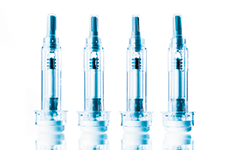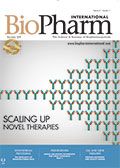Innovations in Prefilled Syringes for Biologic Drugs
As biologic drugs grow increasingly complex, drug delivery mechanisms such as prefilled syringes are being adapted to meet the challenges.
nikkytok/stock.Adobe.com

The increasing complexity of biologic drugs in development is in part driving the need for innovative delivery mechanisms. Innovation in syringe technology is one example of how drugmakers strive to address the challenges of administering these newer therapeutics.
The rapid growth of newer and targeted molecular entities, such as monoclonal antibodies (mAbs), interferons, peptides, vaccines, and ophthalmics; the increasing prevalence of chronic diseases and cancers; and the growth of biosimilars are driving the growth of prefilled syringes. Another factor that contributes to this growth is the need for improved safety and ease of administration for patients and healthcare workers. Prefilled syringes are known to be easy to use and to need only a few administrative steps, which contributes to improved safety (1). In talking with BioPharm International, Nicolas Eon, global product manager of syriQ at SCHOTT, and Claudia Roth, PhD, vice-president Innovation Management at Vetter, discussed key challenges, required standards, and the potential future impact of biologic drug development on the prefilled syringes market.
Biologic drug challenges
BioPharm:What are the main challenges or deficits in prefilled syringe technology today, specifically challenges meeting the needs of biologic drugs?
Eon (SCHOTT):Over two-thirds of the drugs in the development pipeline of pharmaceutical companies are biologics. These drugs offer new treatment options for some of the hardest-to-treat diseases, such as cancer, and chronic diseases. Yet their highly complex molecule structures are more sensitive to temperature and environmental conditions and are prone to interactions with the pharmaceutical container. Hence, biologics require innovative packaging to ensure drug stability over the entire shelf life.
With prefilled glass syringes, the drug comes into contact with up to seven materials, with each presenting a potential risk of interaction. Subsequently, it is of high importance to reduce this risk by using components made of high quality as well as optimized processes. For example, when it comes to gluing the needle, a process optimization of the gluing step can reduce drug/container interactions by minimizing the quantity of residuals glue monomer.
Moreover, biologic drugs tend to be highly viscous, which means that more force is needed during administration. In addition, over 75% of biologics are used in combination with an auto-injector for self-administration. Subsequently, the prefilled syringe must meet highest accurate dimensions as well as ensure that the gliding performance remains consistent from one injection to the next. The mechanical strength of the glass container must also withstand the pressure applied during the administration process.
BioPharm:What specifications are required for packaging biologic drugs in prefilled syringes?
Roth (Vetter):As is often the case, creating easy-to-apply systems means a more complicated production process at the outset. As we know, a prefilled syringe system is a complex construct because it has many individual components. That is why it is critical to achieve the correct individual conjunction and interaction of its parts in order to enable both functionality and usability. For example, when administering a drug with a syringe, you need to have a plunger rod that operates in concert with the other components, especially the glass barrel. To achieve this, a slight coating of lubricant is placed on the inner surface of the glass barrel. Therefore, a key challenge is to define the appropriate coating process and to control the correct amount of lubricant needed to enable the best possible movement of the plunger rod. This must be achieved in a manner that avoids any form of interaction between the lubricant and the drug substance.
In the biologics sector where the active ingredients of compounds are large and very complex molecules, their manufacture is equally complex and challenging. Thus, a vast degree of experience and a substantial level of process expertise is required. Biologics react with far greater sensitivity to environmental influences such as heat or light than other substances do. That is why it is important to design, develop, and implement the correct product-related production processes. For example, using a suitable dosing method and proper pumps in the filling process is critical.
Another example is the fact that biologics can react negatively to the chemical composition of the stopper within the syringe. For manufacturers, this means it is important to have significant knowledge of packaging materials and components.
Eon (SCHOTT):The Parenteral Drug Association’s (PDA) Technical Report (TR) No. 73, Prefilled Syringe User Requirements for Biotechnology Applications(2), published in 2015, can be used as a baseline to design syringes for biological drugs. Depending on the drug and the intended use, the detailed specification must be agreed upon between the biopharma company and the prefilled syringe supplier.
Innovations and future impact
BioPharm:What innovations in prefilled syringes are currently on the market, or in development, to address the challenges that biologic drugs face?
Eon (SCHOTT):SCHOTT recently launched syriQ BioPure, prefillable glass syringes that are specifically designed for self-administered biologics. These syringes ensure drug stability during shelf life and ease-of-administration for patients. The syringes are made of highly inert Fiolax borosilicate glass and are manufactured under improved processes to lower tungsten oxide and adhesive residuals. As more and more biologics are administered in combination with a device, the syringes work with leading safety and auto-injector devices, thus enabling patients to move from hospital to homecare. A uniform silicone layer ensures that the flow rate of the injection process is as smooth as possible, thus enhancing the patient experience.
Roth (Vetter):In our opinion, despite all the innovative activities being considered today, quality will always be the leading criteria of achievement. After all, we are in an industry where patients literally get injected with the products we manufacture for pharma and biotech companies. It is for our customer, as well as the patient, that we make every effort to be as innovative as possible while striving to achieve the highest-possible manufacturing and process quality on a day-by-day basis.
Another central target is achieving compatibility between the active ingredients of a drug and its method of administration. That means it has to be as ‘end-user friendly’ as possible. It is a well-accepted principal that the higher the usability of a drug-delivery system, the greater the acceptance among patients and caregivers. The reasons for this include the homecare sector where a patient-friendly system fits well and contributes to cost avoidance and time-intensive visit to doctors’ offices and hospitals. Also, patient adherence itself is strongly dependent on the convenience level of the drug-delivery system.
To put it simply, whatever protects or increases the safety of a drug-delivery system while increasing its usability is an enhancement and an innovative advance for the market and, ultimately, for the patient.
BioPharm:What trends in biologic drug development do you think will have an impact on the future development of prefilled syringe technology?
Eon (SCHOTT):One trend we see is the higher complexity of biologics as well as the higher sensitivity of the drugs. This results in the need for a superior extractables and leachables profile of the pharmaceutical primary packaging. More specifically, this means that the amount of tungsten and glue residual must be minimized, and the selected rubber formulations carefully considered. In addition, the options for lubrication, such as the use of silicone, must be evaluated.
Another trend is the move from hospital to homecare to allow patients to self-administer the drugs in an environment where they feel most comfortable. To ensure that this is as easy and safe for the patient as possible, the self-injection is handled in combination with a device, such as auto-injectors. For the development of prefilled syringes this means that the container must be compatible with a number of devices and meet the specific requirements and dimensions.
The rise in personalized medicine, including biologics, targeting small target groups also effects the development of prefilled syringes. Due to the smaller batch sizes that are required, a new supply chain concept and a flexible platform approach are needed. This flexibility can be introduced early on in the drug development process by using standard secondary packaging for the primary packaging. For example, SCHOTT recently launched its iQ platform concept in which syringes, including syriQ BioPure, are packaged in a standardized tub, which simplifies the changeover from, for example, vials to prefilled syringes to run on one filling line. Subsequently, the syringe development needs to fit in with a broader picture in order to meet market demands.
Lastly, the industry is confronted with more stringent regulations, which require the packaging to provide ‘design history file-ready’ documentation and be ‘essentially free of particle’. SCHOTT continuously improves its process and online inspection technology to ensure compliance with current and future regulatory requirements.
References
1. K.J. Wrigley, Pharmaceutical Technology 41 (10) 32–35 (2017).
2. PDA, TR No. 73, Prefilled Syringe User Requirements for Biotechnology Applications, 2015.
Article Details
BioPharm International
Vol. 31, Number 11
November 2018
Pages: 41–43
Citation
When referring to this article, please cite as F. Mirasol, “Innovations in Prefilled Syringes for Biologic Drugs,” BioPharm International 31 (11) 2018.

Meeting Secondary Packaging Challenges of Innovative Delivery Systems for Biologics
February 5th 2025Rapid market growth in biologics is helping the packaging market expand as well, but the complex nature of biologics and the desire for personalized therapies present unique hurdles to make packaging solutions cost-effective and safe for patients.